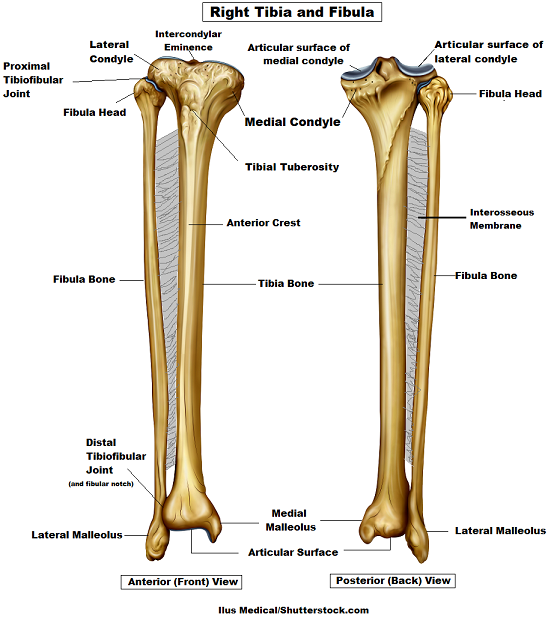The bony structure of human is does complex structure that is difficult to be dealt with holistically. We have the short and long bones, the round bones, flat bones, the sternum which consists of the rib cage, the bone of the skull, the scapula and many other different bony structure. In this context, we want to look at the long bones of the hind limbs and their function the human bone structure.

The Femur Bone
The femur bone, also known as the thigh bone, is the longest and strongest bone in the human body. It is located in the upper leg, between the hip and the knee. The femur plays a crucial role in supporting the body's weight and aiding in various movements such as walking, running, and jumping.
The femur has several important anatomical features. At the proximal end, it articulates with the hip bone to form the hip joint. The rounded head of the femur fits into the socket of the hip, allowing for a wide range of motion. Connected to the head is the neck of the femur, which is a common site for fractures, especially in elderly individuals.
The shaft of the femur is long and cylindrical, designed to bear weight and resist forces during activities. It has a slightly curved shape, giving it additional strength. The lower end of the femur expands into two rounded condyles that articulate with the tibia bone in the lower leg, forming the knee joint.
Along the length of the femur, various muscles and tendons attach to facilitate movement. These include the quadriceps muscles at the front of the thigh, which extend the knee, and the hamstring muscles at the back of the thigh, which bend the knee.
In case of injuries or fractures to the femur, medical intervention such as casting, traction, or surgery may be required for proper healing. Rehabilitation exercises and physical therapy may also be necessary to restore strength and function following femur injuries.
Overall, the femur bone is a remarkable structure that provides essential support and mobility to the human body.
The Humerus Bone
The humerus bone is one of the long bones in the human body. It is located in the upper arm, extending from the shoulder joint to the elbow joint. The humerus is considered the largest bone in the arm and plays a significant role in our ability to perform various arm movements.
The humerus bone consists of several distinct parts. The proximal end of the bone connects to the shoulder blade (scapula) through the shoulder joint. At the proximal end, you'll find the head of the humerus, which is rounded and articulates with the glenoid cavity of the scapula, forming the shoulder joint.
Moving down the humerus, you will encounter the anatomical neck, which is a slightly narrowed area just below the head. Further down is the greater tubercle, a prominence on the lateral side of the humerus, serving as the attachment site for muscles involved in shoulder movements.
Continuing downwards, you'll find the shaft of the humerus, the long and cylindrical middle portion of the bone. It has several notable features, including the deltoid tuberosity, where the deltoid muscle attaches, and the radial groove, which accommodates the radial nerve.
Finally, at the distal end of the humerus, you'll find the capitulum and trochlea. These are important structures that articulate with the bones of the forearm (radius and ulna) at the elbow joint, allowing for forearm movement.
The humerus bone is vital for the overall functionality and range of motion of the arm. It provides attachment points for numerous muscles involved in arm and shoulder movement. Understanding the anatomy and function of the humerus bone is crucial in diagnosing and treating any injuries or conditions that may affect the upper arm.
The Tibia & Fibula Bones
The tibia and fibula are both bones located in the lower leg, but they differ in terms of their structure, function, and placement within the leg.
Structure: The tibia, also known as the shinbone, is the larger and stronger of the two bones. It runs parallel to the fibula, on the inner side of the leg. The tibia has a prominent ridge called the shin, which can be easily felt beneath the skin. In contrast, the fibula is slender and lies next to the tibia on the outer side of the leg. It is considered the non-weight-bearing bone of the lower leg.
Function: The tibia plays a key role in weight-bearing and bears the majority of the body's weight during activities such as walking, running, and standing. It provides support, stability, and strength to the leg. On the other hand, the fibula assists in muscle attachment and plays a minor role in supporting body weight. It mainly serves as a site for muscle attachment, particularly for muscles involved in ankle and foot movements.
Articulation: The tibia connects to the femur (thigh bone) at the knee joint, forming an important part of the knee's structure and stability. It also articulates with the talus bone in the ankle joint. The fibula, however, does not directly connect to the femur but rather acts as a stabilizing and anchoring point for muscles and ligaments in the lower leg and foot.
Fracture patterns: Fractures of the tibia are more common than those of the fibula due to its weight-bearing function. Tibial fractures often result from high-impact injuries or excessive stress. Fibula fractures, on the other hand, are usually associated with ankle sprains or rotational injuries. Since the fibula is not heavily involved in weight-bearing, a fibula fracture typically does not significantly affect one's ability to walk or bear weight.
In summary, the tibia and fibula are two bones in the lower leg with differing roles. The tibia is larger, stronger, and primarily responsible for weight-bearing, while the fibula is smaller, assists in muscle attachment, and plays a supportive role. Understanding the differences between these bones can aid in diagnosing and treating injuries or conditions related to the lower leg.


